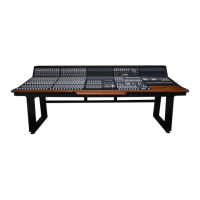41
Mixing
Getting Audio From DAW to Console
Recorded tracks should be brought back onto the console using the DAW/Tape Returns, which
come in on the Long Faders by default. Ensuring that the MTR flip buttons are disengaged, signal
should appear on the long meters for each active channel strip.
Engage the Mix buttons for the Long Faders and bring up the faders to 0dB for channels that are
in use. Signal should now appear on the main meters in the master section, and you should be
able to hear the recorded tracks.
Subgroups
ASP8024-HE has eight subgroups, which allows you to group certain tracks together and give
you control over their overall level (drums channels for example). Sub Groups can be set by using
the first eight buttons of the Bus Routing Matrix at the top of the channels, ensuring that the Bus
Routing is flipped to the LF path by pressing the LF button next to the switch matrix.
To create a stereo sub-mix, press the Follow Pan button. This causes the odd Multi-track Buses to
take signal from the left side and the even numbers from the right. For example, on each channel,
you would press down a pair of Multi- track buttons such as 1 and 2. Any channel that is panned
fully left will appear on Sub Group 1, and any channel panned fully right appears on Sub Group 2,
with channels panned in between being split between Sub Groups.
Adding EQ to Tracks
EQ can be added to channels to allow them to sit better together, or just for creative purposes. To
do this, press the IN button on the band of EQ you want to add to the channel.
For more broad equalisation, the Shelving EQs are best and allow you to add additional low end
or high frequencies to that track. The Parametric EQs allow you to sweep frequencies and adjust
the bandwidth of the EQ. This gives you more control over what is being cut or boosted and is
great for surgical cuts of problem frequencies.

